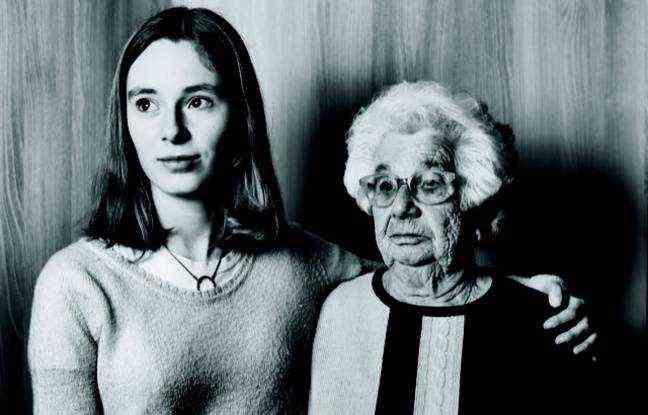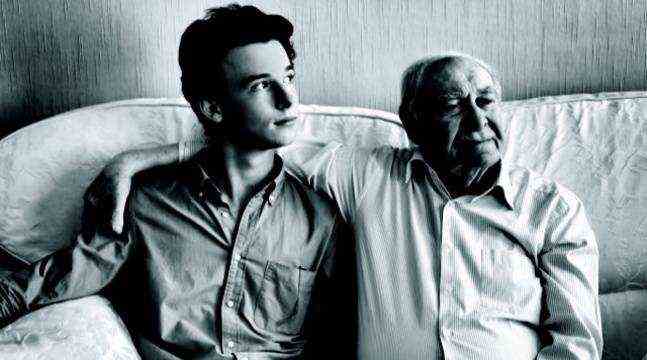Alexandre alongside Milo Adoner, deported at 17. – Karine Sicard Bouvatier,
- This Sunday is the national day of remembrance of the victims of the deportation. The opportunity for 20 minutes to interview Karine Sicard Bouvatier, the author of Deportees, their ultimate transmission *, which just appeared.
- A book which recounts the meeting of twenty-five camp survivors with adolescents of their own age at the time of their arrest.
- Since then, seven of the deportees who testified have died, but their story is now eternal.
Create bridges between generations, pass on History and life lessons. For two and a half years, Karine Sicard Bouvatier, author and photographer, organized meetings between survivors of camps during the Second World War and young people of their age at the time of their arrest. Heartbreaking moments that she immortalized and which appear in her book Deportees, their ultimate transmission *, recently published in bookstores. For 20 minutes, and on the occasion of Sunday, National Day of Remembrance of the Victims of Deportation, she returns to this historic handover.
How did you come up with the idea of connecting young people and deportees?
In 2018, I met Yves Bokshorn, deported to Mauthausen, and Pierre Gascon, deported to Buchenwald. My children were about the age they were when they were deported. I told myself that there were few camp survivors left in France (around fifty in 2018) and that our children would be the last generation to be able to meet them. And that this handover had to be organized through portraits and testimonies.
I was aware that we had to act quickly because they were between 92 and 98 years old. And besides, of the twenty-five deportees that I met, seven have now died.
How did you come into contact with these survivors?
Through the Shoah Memorial, associations of deportees or by word of mouth. When I proposed to them to participate in this project, no one refused to refuse me. What prompted them to participate in my project was that it was a dialogue with a young person and that they were aware that they would soon pass away.
I traveled across France to meet them for two and a half years; twenty-three of them were deported because they were Jews, and two because they were resistant.
Had they all already testified to their story?
Not all. For example, Yves Bokshorn had never done so. But even for those who had already told their story many times, talking about it was still very painful. Every other time there were tears. Their speech on the subject was not established. Even though seventy-five years had passed, the emotion was still intact. And despite their advanced age, their memory had remained very precise: they remembered the dates very well, evoked very precisely the sensations of cold, blows, suffering, hunger … The rare gestures of solidarity received from others deportees had also remained very anchored.
For many camp survivors, telling their own children about their story has been very difficult, if not impossible. Was this the case for them?
Yes. Elie Buzyn told me that talking to his children was like injecting them with a syringe of poison. He didn’t want to convey trauma to them. It was a little less complicated to talk to strangers about it.
For your book, you have chosen young people from different social origins and different religions. Why ?
I wanted to represent a form of diversity among these young people, because the history of the deportees has nothing to do with the community, it belongs to everyone. And every adolescent must participate in the fight against anti-Semitism at his level. I myself am a Protestant and the Shoah haunted me a lot. Memory exercise is essential.
Did the adolescents identify with the deportees, and vice versa?
By listening to these testimonies from our elders, they put themselves in their shoes. Gaston, 11, who met Léon Placek, wrote after their meeting: “He was my age, how would I have done? Many were very impressed and few talk. They were fascinated by the courage of these people who came back from so far. They understood that it was necessary to be attentive to human distress and to fight against anti-Semitism.
The mirror effect also played with the survivors of the camps who, looking at the teenager in front of them, saw each other again at the same age, when this tragedy befell them.

Your photos reveal gestures of tenderness between the survivor and the young person. Some teens even seem to protect their older sibling. How do you explain it?
It is like a family bond between them. Most of the children wrote a thank you note after they met. But they did not necessarily stay in regular contact, because each one has left in his life. Still, the teenagers were very marked. They told their loved ones about it and will remember it for the rest of their lives.
The survivors gave advice to the young people, including that of developing a political conscience. How do you explain it?
They recommended to them to be attentive to the progress of the world, to watch over democracy, to oppose words of exclusion, in order to always remain vigilant in the face of the risk of tragedy.
* Deportees, their ultimate transmission, of Karine Sicard Bouvatier, Edition de la Martinière, 25 euros.

